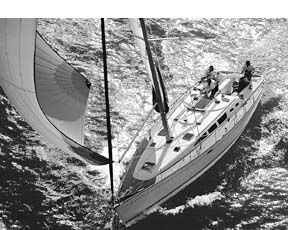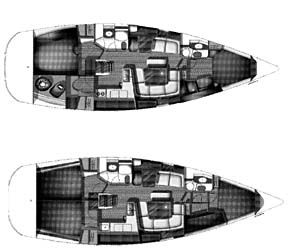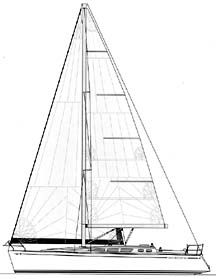Jeanneau’s product line falls into two categories: Sun Odyssey models characterized as “performance cruisers,” having a turn of speed, and the Fast series boats, which are designed for performance sailors.
Since performance cruisers are often compromises created by manufacturers attempting to respond to the need for comfortable accommodations, we were favorably impressed with this boat’s performance under sail. Note the displacement/length ratio of 175—well into the realm of the zippy.
Two basic configurations are offered belowdecks—one that will offer civilized comfort to a small crew, the other that will provide bunks for 11. Presumably the latter configuration would be aimed at the charter trade, but the idea of stuffing that many people inside causes a shudder.
Leaving aside the vision of a platform quite that rife with personnel, we find a boat that’s well-designed and well-built.
Company History
Following two decades of topsy- turvy changes in its ownership and financial condition, Jeanneau has enjoyed several years of stable management and profitability since being brought under the Groupe Beneteau umbrella in 1995.

When founded in 1956 by Frenchman Henri Jeanneau, the company’s primary focus was the construction of small, outboard-powered boats. However, by the early 1970s, its emphasis shifted to the production of sailboats. Since it enjoyed a modicum of success during years when conglomerates were gobbling up small manufacturers like whales after krill, the company became an acquisition target for then-prosperous Bangor Punta. When Bangor-Punta suffered a financial shortfall, Jeanneau was sold to Chatellier Industries, which continued the saga by selling to Beneteau in 1995.
Jeanneau is now one of the most prosperous manufacturers in the industry. The company produces more than 4,000 boats annually at its plant in Les Herbiers, France, of which 1,200 are sailboats ranging in size from 17 to 52 feet. Gross sales are reportedly in excess of $125,000,000.
Jeanneau’s North American distribution system includes 19 dealers in the US and Canada.
Design
Paul Fenn, managing director of Jeanneau America, a wholly owned subsidiary, says the target market for Jeanneau’s boats are “Europeans who tend to appreciate good sailing performance over massive interior accommodations like many of the American manufacturers are producing. Our target market in the US is the guy looking for a good sailing boat with nice accommodations and a production price. This boat was designed for sailing performance, so we gave up some interior volume.”
Designs for Jeanneau’s products flow from the boards of Daniel Andrieu and his design team. Designs are a by-product of top management’s decisions on a range of concepts that Andrieu executes using computerized drafting systems common to the powerboat industry. The CAD-CAM allows designers to develop hull shapes, sailplans, and ergonomics in living spaces before a prototype is developed.
Despite her European pedigree, the SO43 hull does not share the rounded profile and cabintop of many of her curvy contemporaries. Rather, the nearly plumb bow has a fine entry. Her sheerline is nearly flat, and ports are tall enough to allow light to flow belowdecks without elevating a rather low, traditional profile on the cabintop. She carries her beam well aft and has a wide stern that is less rounded than many American production boats.
Under sail, the high-aspect mainsail and double-spreader rig compliment her profile. From a purely aesthetic standpoint, she’s a looker.
Construction
Though Jeanneau and Beneteau share a fierce rivalry for market share, the joint ownership of the two firms produces many construction benefits. Their combined purchasing power and assembly methods produce economies of scale that result in cost savings to purchasers.
To its credit, Jeanneau became the first French boat builder to receive ISO 9000 Certification, a European standard that documents each step in the production process and theoretically assures purchasers of a consistent level of quality in construction.
The two firms also share the same heritage in a carpenter’s shop that boasts two unique characteristics. First, to produce matching grain on interior surfaces, the raw materials are carved from the same log. Second, the company claims that a “computer –controlled carpenter” cuts and mills wood to within 0.1 millimeter of design specs. Based on our inspection of one boat, the claim may be justified.
The lamination schedule is interesting. Hulls are hand-laid solid fiberglass, which the company says is “Kevlar energized.” Following the application of gelcoat, layers of 300-gram and 450-gram mat are bonded with vinylester resins to prevent water penetrating the outer skin. Subsequent layers of mat and roving are bonded with polyester resin, after which the structure is encapsulated in a 450-gram layer of Aramat 76K6, a mixture of glass fiber and Kevlar. Kevlar has the advantage of being tough and light, and in this application has no hard corners to turn. The bottom of the hull is two inches thick.
Reinforcement for the hull is provided by a series of longitudinal stringers constructed of solid hardwood encapsulated in fiberglass, and grids. Bulkheads and cabinetry are attached to the hull in molded channels with Sikaflex adhesive. The only pans in the boat are in the heads, which are not relied upon to provide structural support, and in the engine area. Reinforcement for the rudder post is a triangular shaped collar that provides additional support.
Except in high-load areas, horizontal sections of the decks are cored with discontinuous balsa blocks encapsulated in hand-laid layers of fiber cloth. Beds for cleats, stoppers, the mast, winches, tracks, and chainplates are constructed of solid wood. All of the deck hardware is bolted through wood and backed with washers.
The hull-deck joint is typical of most production manufacturers. The outer edge of the deck is laid atop an inward-oriented flange molded on the top edge of the hull. The two sections are bonded by Sikaflex and further secured by self- tapping screws on 10-cm centers. The toerail is then installed over the seam, and secured through the deck and hull flange with screws.
Though the seam should not leak, we’re still of the opinion that hull-deck joints should be through-bolted rather than screwed, although there’s an argument to be made that today’s sealants, properly applied, are rugged and sticky enough to do both the sealing and the structural bonding alone.
On balance, the construction methods used on this boat are at the higher-quality end of mass production. It may be that long years of experience, efficient techniques, and the company’s financial resources allow it to produce this relatively high quality at a moderate price.
Deck Layout
Like many contemporary production boats, the SO43’s deck arrangement is designed to accommodate the strength and athletic ability of a shorthanded crew of middle-aged sailors: Internal halyards are led aft to rope clutches on the cabintop at the companionway. A spacious cockpit is outfitted with a built-in table, and a swim platform is equipped with a built-in ladder.
Performance-enhancing hardware, like a hydraulic backstay or racing headstay, are options that would produce more speed, but it seems more likely that owners of these boats will add furling mainsails and electric winches.
The standard rig is a Red Label mast constructed by Diffusion of France and equipped with two sets of slightly swept spreaders. Our test boat was equipped with an Elvström mainsail with an optional furler, and ProFurl furler on the headstay. The latter is standard equipment.
Mainsail controls are on a traveler located forward of a molded lip designed to facilitate the installation of a dodger. The traveler seems far too short to be of much help in depowering the main in a big breeze, although it would be fine for centering the boom in light air. It appears that after installation of the dodger, space will be adequate for winch handles to rotate 360 degrees.
The headsail tracks run from aft of the chainplates to the cockpit, a plus since that allows good sheeting angles, even when sailing under a reefed main and shortened jib.
Though rarely seen on American boats, the bow pulpit is split into two sections, which facilitates retrieval of the anchor, a design we’ve found easy to use on other boats. Bow cleats are 13″ long and have enough clearance for the heavy lines needed to keep the boat anchored in a blow.
Following a trend that seems to be growing in popularity, the boat is equipped with two wheels. Our initial impression was that this type of arrangement outside the racing environment was eye candy, but we’re coming around. In this case, the boat can be steered from a seat behind the 36-inch destroyer wheels, or from the rail. The cable steering system produces a surprisingly responsive helm. It’s also easier to move about than with a 60-incher located amidships. We found a very comfortable spot outboard in the corner of the stern pulpit that provided excellent views to the telltales and a comfortable backrest.
We still have a concern that the added mechanical complexity of a two-wheel system would prove extra challenging in the event of a steering system failure. Owners should make themselves intimately familiar with the system belowdecks, and think through their emergency steering response.
Binnacles are mounted on pre-molded bases in a fiberglass deck pod that produces a tidy arrangement. Instruments are installed at both wheels; engine controls are to starboard at the helmsman’s fingertips.
The cockpit is spacious, measuring eight feet on the centerline. Seats are 66″ long and 17″ wide. The 11″high backrests could be a tad higher for comfort, but they’re a good height for crew assigned to grind a winch.
A built-in table located on the center line has two folding leaves. It measures 48″ long by 14″ wide, large enough seating for four adults. When open, leaves add 26″ of width. They’re supported by pipes tucked under the centerpiece that slide outward, a clever way to produce a stable platform.
Primary winches are Harken two- speed 53 self-tailers; those on the coachtop are Harken 44s. Our test boat wasn’t equipped with spinnaker gear, but the coaming had molded, recessed pads for secondary winches.
Depending on the interior layout, the boat will have either a big sail locker to starboard or a stowage tray over the aft cabin, large enough for six full-sized fenders and dock lines. Space in a lazarette in the port quarter is large enough for sails, or an inflatable, though the space will be compromised if a heater is installed.
The designer’s choice of 24″ high stanchions and lifelines is strangely minimalist, in our view, especially on a boat this size. A stanchion height of 28-30″ is far preferable.
There are seven Goiot hatches located on deck, and four ports in the cabinsides. The largest hatch, located over the forepeak, measures 20×20″; others are 12″ and 18″ square.
Belowdecks
Access belowdecks is via five steps that lead to the saloon, with galley and large settee to starboard, and head, nav station and a second settee to port. The entire area is filled with Burmese teak.

Depending upon the configuration of spaces belowdecks, the boat will sleep no less than 11 crewmembers. We can’t imagine 11 adults sleeping below on a rainy night with the hatches secured. A crew that size also will exert maximum pressure on storage lockers.
Our test boat featured staterooms aft, port and starboard, outfitted with double berths measuring 82″ long on center and 64″ wide. The partition between the two compartments is composed of easily removable sections of wood that would convert the space into a padded area roughly the size of Delaware. There is good storage throughout the two compartments.
The galley is an L-shaped affair with an Eno stainless steel stove/oven combination mounted aft at the bulkhead. Since counter space on any boat is at a premium, a 20×15″ tray, custom cut to fit the top of the stove, adds a portable working surface.
There’s adequate storage in four wood-lined cabinets located outboard, one of which is a glass holder. Like all of the joinery belowdecks, the cabinets reflected attention to detail in both fit and finish.
The refrigerator is located under a 24×48″ counter that adds to the chef’s working surface. Access is from the top of the counter, and through a door—a plus, since it seems the stores we’re looking for are invariably on the bottom shelf.
The C-shaped settee provides seating for six to eight guests, including two on a bench amidships. The bench doubles as a storage compartment and, when underway or at night, slides to a locked position beneath the table. A second settee that measures 46x 23″ converts to an 88″ long berth when a wood panel is inserted between the end of the settee and the navigator’s seat.
The seat at the nav station faces forward. The chart table is 27×22″—a functional if not generously sized surface. Instruments and a circuit breaker panel are to port, and there’s adequate space for installation of VHF radio and GPS/chartplotter. Several screws need to be removed to access the space behind the circuit board. A simple hinged panel would be better.
The heads are strikingly dissimilar. The aft head is accessed from the stateroom aft and the saloon, and is equipped with toilet, a vanity measuring 15×20″, and a sink. A 14×18″ mirror covers the medicine cabinet. The shower compartment, which is enclosed by a curtain, provides a seated bather with decent elbow-room.
The forward head is long and narrow, with the space between the edge of the sink and the door measuring only 16″. Odds are, brushing your teeth while leaning over the sink will require a contortionist act, or the function will need to be performed with the door open. The other key head function can be performed comfortably wedged in place—an advantage in a seaway, although, in the words of one dealer, “the space in the toilet is too small for this six-foot-tall, 230-pounder.” Showering in this compartment will be a real challenge.
The forward stateroom is enclosed by a door and latch fitted so closely to the head that, absent a stopper, it will eventually damage the head door. A full-height hanging locker is located to starboard. The berth is 55″ wide at the shoulder. We thought this a bit narrow, but tried it with two adults lying side by side, and changed our opinion. (This opinion, of course, may vary, depending on which adults are used…) The berth measures 80″ on the centerline; however, because of the hull’s fine entry, four (human) feet will be forced into entanglement in such a narrow space.
Performance
With the assistance of Ian Fraser of Fraser Yachts in Vancouver, BC, and the indulgence of the new boat’s owners, we sailed on her maiden voyage.We tested on a gray day in winds that fluctuated between zero and 10 knots as a low-pressure system moved through the area.

We tested her three ways: under full sail, under full power, and under bare poles without power when we ran out of fuel. She receives high marks in all areas.
Powered by a 76-hp Yanmar diesel with a three-bladed propeller, she motored at 8.6 knots over the ground at 2,500 rpm. With the throttle wide open, speed increased to 9.6 knots at 3,700 rpm.
Then, sailing in 5- to 7-knot winds under full main and 135-percent genoa, she registered 5.5 to 6 knots of boatspeed sailing hard on the breeze into a 2 -3′ swell. Considering that the rig needed tuning and she was equipped with furlers on both sails, we consider that good performance. We noted that an increase of only two knots in windspeed increased boatspeed over the ground to more than six knots while sailing into an ebbing current.
When 10- to 15-knot puffs blew through she accelerated quickly without loading up the helm, and speed reached eight-plus knots when we footed off to a close reach.
Ultimately, when the engine died while returning to the marina, we discovered that she’ll ghost along even in light zephyrs. Entering the marina without engine or sail power, she maneuvered so smartly to a dock that we managed a soft landing without putting a blemish in the gelcoat.
That taste of her performance left us hungry for a longer sea trial.
Conclusion
The Sun Odyssey 43 warrants close inspection by sailors interested in a turn of speed coupled with nicely finished creature comforts. The twowheel configuration we once considered an indulgence may be a good idea on bigger boats.
She’s equipped with brand name hardware that makes for easy sailing. The cockpit is large enough for entertaining. Spaces belowdecks are well appointed, nicely furnished, and well conceived. The galley is large and well-organized.
We like the versatility of the aft stateroom combination. The navigator can work in comfortable surroundings. In general, the two-cabin layout will have good stowage throughout, and the four-cabin version will suffer for lack of it.
She performs well, like many of her sisters. She’s priced competitively with her closest rivals in the production world: $195,000 FOB Baltimore, including import costs, customs and duty. Jeanneau provides a five-year warranty on the hull and deck, and one year on other components.
Contact- Jeanneau America, 105 Eastern Avenue, Suite 202, Annapolis, MD, 21403; 410/280-9400; www.jeanneau.com.







































